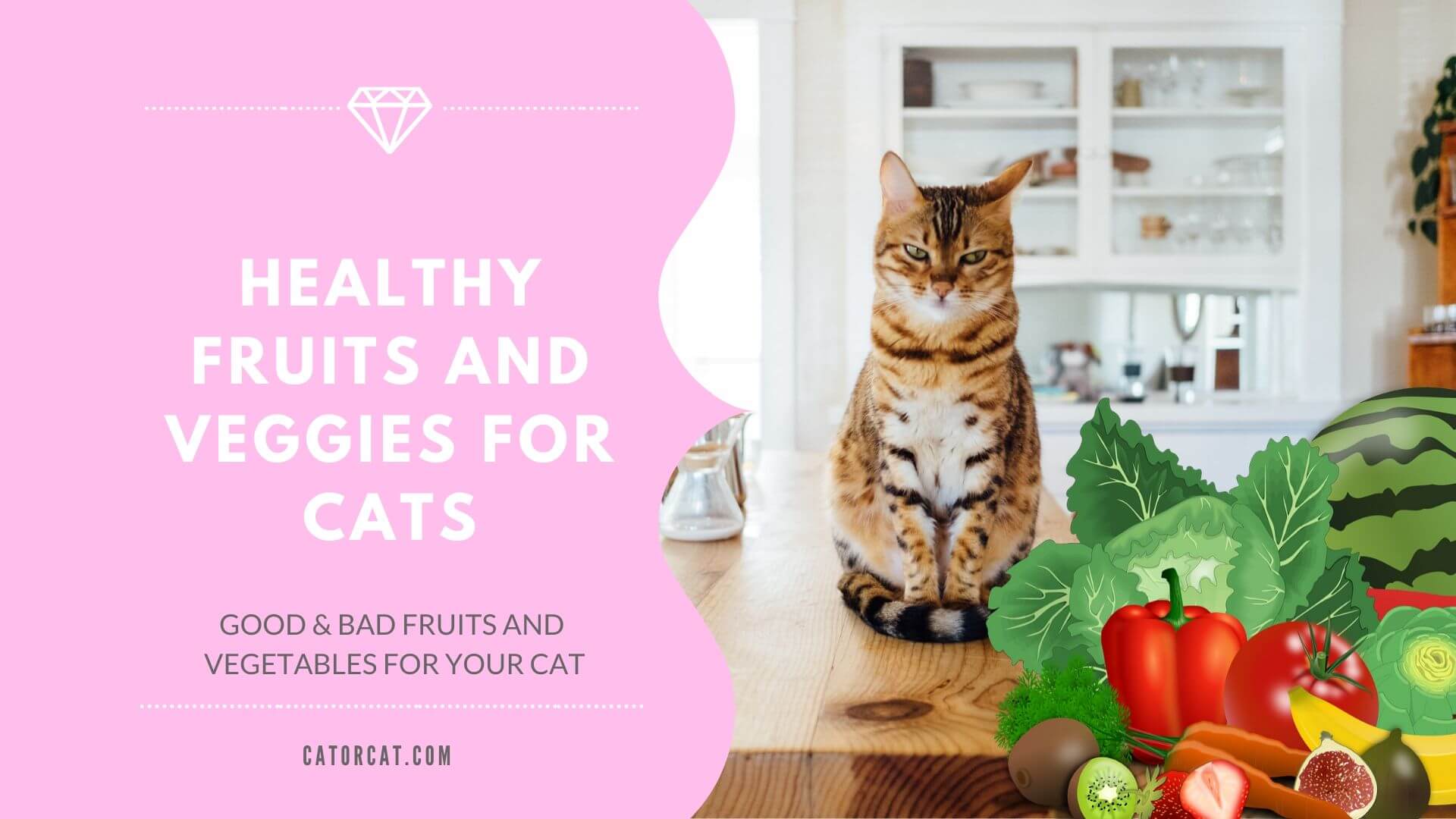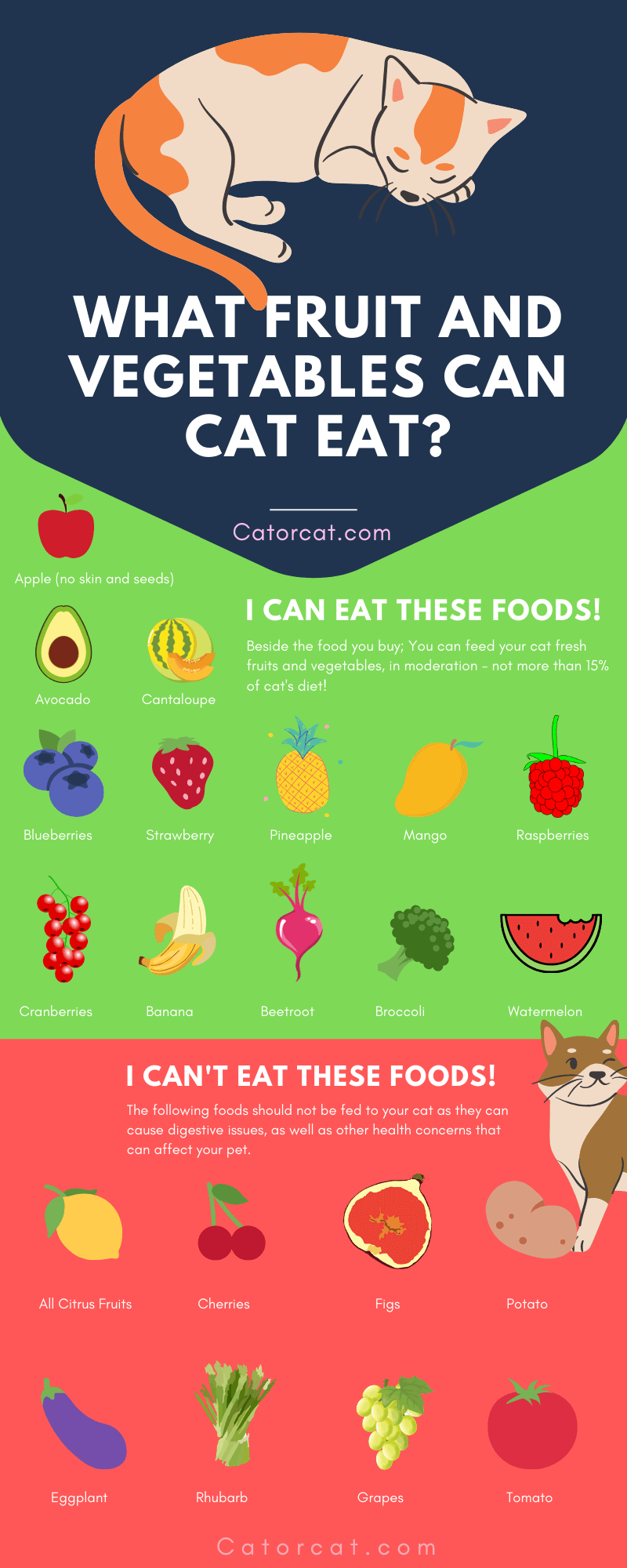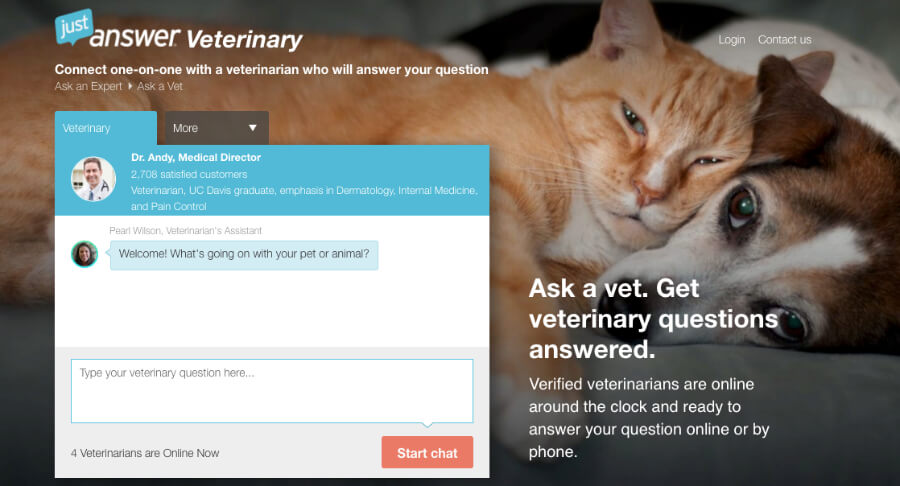
While it’s tempting to feed our cats the food that we love to eat, it’s probably not a good idea. You may love to eat apples and oranges, but your cats might not. While fruits and vegetables are generally safe for them to eat, there are certain foods that must be avoided by your feline friends at all costs.
Cats are hypercarnivores in nature. This means their digestive systems require a meat-based diet. Cats cannot properly digest plants, and it causes them several digestive issues such as vomiting, indigestion, constipation, and diarrhea.
But while they can’t really digest plants, they can still eat fruits and vegetables in moderation. Some fruits and veggies provide great nutrition for kitties and for this fact alone, it’s safe to feed them small quantities from time to time.So let’s get down to it. What are the fruits and vegetables that cats can eat, and what can’t they eat?
[Infographic] Vegetables & Fruits cats can eat!

Here are 13 fruits and vegetables that are safe for cats to eat, and 8 that must be avoided at all times.
Fruits and Vegetables that are Safe to Eat for Cats
1. Apples
Cats can eat apples as long as you remove the peeling and the core. If you don’t remove the core, however, it can be dangerous to your cat. Why? Because apple seeds contain amygdalin, which is known to break down and produce toxic cyanide.While the cyanide content in apple seeds is too small of an amount to poison humans, they can be toxic to cats. So always make sure to cut the apple in slices and that the peel and core are out of the picture.
2. Avocados
Cats can eat the flesh of the avocado but make sure you only feed her the flesh and nothing else. The leaves, skin, and bark of the avocado contain the oil-soluble compound persin, which is mildly toxic to cats.
3. Banana
Bananas are safe for cats to eat. It’s also a great source of potassium, Vitamins B6, and Vitamin C. The high potassium content in bananas helps to support kidney and heart functions in cats.However, because bananas contain high amounts of sugar, you have to feed your cat in moderation.
4. Beetroot
Beetroot is completely safe to eat for cats. However, beetroot can cause pigmentation of the urine and feces, which can resemble blood. If your cat is suffering from a urinary tract infection or suffering from irritable bowel syndrome, it’s best that you don’t feed her beetroot so you have a better gauge of whether or not their condition is becoming severe.
5. Blueberries
Cats can eat blueberries and they’re a great source of vitamins and minerals. Blueberries are rich in antioxidants, potassium, and Vitamin C. It also helps in preventing tissue and cell damage, as well as reduce the chances of the development of urinary tract disease and infections. Plus, blueberries can improve your cat’s night vision capacity.
6. Broccoli
Yes, cats can eat steamed broccoli and it’s a great source of fiber and protein. It also contains iron, potassium, calcium, selenium, magnesium, and a host of vitamins such as Vitamin A, B, C, E, and K.
7. Cantaloupe
Cantaloupe is a safe fruit for cats to eat as long as you remove the skin. The skin may contain harmful bacteria and cause disease in your cat. Its anti-inflammatory properties are great for senior cats, and its vitamin content of Vitamins A, B, C, are great for added nutrition.
8. Cranberries
Cats can eat cranberries and it’s a great fruit to fight infections of the urinary tract. It also contains manganese, fiber, and vitamin C.
9. Mango
Mango is great for the cat’s digestive systems but make sure your cat does not ingest the pit as it contains cyanide, just like apples. Make sure when you feed your cat mango, it only contains the flesh.
10. Pineapple
Pineapples are a great source of zinc and folate for cats. It promotes immune and digestive health, but since it’s a highly sugary fruit, always keep it to a minimum. Also, you need to ensure the spiky skin and hard core are not included when you feed your cat pineapple as they pose choking hazards.
11. Raspberries
It’s okay for cats to eat raspberries and it’s great for its nutritional content. It has Vitamin C, high fiber content, and has anti-inflammatory features. However, raspberries contain a sweetener called xylitol, which can be fatal to cats when eaten in large amounts. Like pineapple, you have to make sure you keep it to a minimum.
12. Strawberries
Yes, you can feed your cat strawberries. It promotes overall health, strengthens the immune system, and slows the process of aging.
13. Watermelon
We all know that cats are not the biggest drinkers. This is why watermelon is a great fruit to help promote hydration in cats. Watermelon is composed of 90% water, as well as containing potassium, Vitamins B6, A, and C. It is also known to improve nerve and muscle function in cats.
Just like us, cats needs the right nutrients in the right amount so they can achieve optimal health. Add vitamins and minerals to her diet!
Fruits and Vegetables that are Not Safe for Cats to Eat
So now that we’ve listed the fruits and vegetables that are safe for cats to eat, let’s begin our list of the fruits and veggies that your cat must not eat at all times. Let’s begin with the first on our list.
1. Cherries
Cats should never eat cherries as they are highly toxic to them even when consumed in small quantities.
2. Citrus Fruits
Cats don’t like the tangy flavor of citrus fruits. This includes lime, lemon, grapefruit, and even oranges. The oil in the peels of citrus fruits can cause serious reactions, but it also contains psoralens. Psoralens are mildly toxic to cats and can cause gastrointestinal issues.
3. Figs
Figs are a no-no to cats as they are highly toxic and can even cause death even when cats consume small amounts.
4. Grapes
Grapes can cause acute kidney failure in dogs and it’s far too great a risk to feed them to cats.
5. Eggplants
While there isn’t so much information about whether or not eggplants are good or bad for cats, eggplants are a member of the nightshade family. Vegetables that belong to this plant family contain solanine, which is known to be toxic to cats.
6. Potato
Potatoes are also members of the nightshade family and contain solanine. Potatoes with green on the skin contain the highest levels. While there’s not much information on potatoes, as well, it’s always better to be safe than sorry.
7. Rhubarb
Rhubarb is a big no-no to cats. It’s toxic due to its soluble calcium oxalate crystal content. The highest amount is found on the leaves but they are also present in the stalks.Soluble calcium oxalate crystals are known to cause blood calcium levels to drop and in some cases, rhubarb can cause acute kidney failure in cats.
8. Tomato
While ripe tomato is completely safe for cats to eat, green tomatoes are not. The leaves, stems, and green tomato contain solanine, which is toxic to cats and can cause gastrointestinal problems.
Can Your Cat Have a Vegetarian Diet?
The answer to this question is a big no! Cats need meat to survive. While vegetarian cat parents may feel heartbroken that they can’t let their cats go vegan or vegetarian, it is a must to them to eat meat on a regular basis.The nutritional needs of cats cannot be met with fruits and vegetables alone. If you are putting them on a vegetarian diet and they may seem okay now, in the long-run, they won’t be. A vegetarian diet for a cat is a death sentence.If you must feed your cat fruits and veggies, always make sure you follow these tips:
- Make sure the peeling or skin, and seeds are removed to be on the safe side.
- Always feed them in moderation.
The Bottom Line
While eating fruits and vegetables make humans healthy, it is not the best diet for cats as they are obligate carnivores and we have to respect this fact of nature. It is also a must that human food should not exceed 15% of a cat’s diet. So just because you love munching on grapes and raisins, doesn’t mean it’s safe for cats to eat.Make sure you do your research when it comes to feeding your cat so you ensure their health, and survival, too.
One of the best food for your cat would be wet food, because it contains all the necessary nutrients!
Related:

